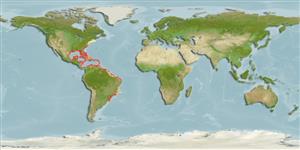Classification / Names
Common names from other countries
Main reference
Size / Weight / Age
Max length : 60.0 cm TL male/unsexed; (Ref. 26938); common length : 35.0 cm TL male/unsexed; (Ref. 55); max. published weight: 3.2 kg (Ref. 40637); max. reported age: 10 years (Ref. 3090)
Length at first maturity
Lm ?, range 15 - 23 cm
Environment
Marine; demersal; depth range 40 - 300 m (Ref. 9626), usually 40 - 100 m (Ref. 9626)
Climate / Range
Subtropical, preferred 27°C (Ref. 107945); 42°N - 33°S, 99°W - 30°W (Ref. 55)
Distribution
Western Atlantic: Bermuda and North Carolina, USA, to São Paulo, Brazil (Ref. 57756), including West Indies, Gulf of Mexico and Caribbean Sea (Anderson, pers. comm.).
Countries | FAO areas | Ecosystems | Occurrences | Introductions
Short description
Dorsal
spines
(total): 12 - 13;
Dorsal
soft rays
(total): 10-11;
Anal
spines: 3;
Anal
soft rays: 8. Snout short, lower jaw slightly projecting. Mouth small. Pectoral fins relatively short, not reaching level of anus. Scale rows on back rising obliquely above lateral line. Back and upper sides vermilion, shading to silvery with reddish tinge ventrally, with narrow horizontal yellow lines below the lateral line. The dorsal and caudal fins yellowish; the anal and pelvic fins whitish.
IUCN Red List Status (Ref. 115185)
Threat to humans
Harmless
Human uses
Fisheries: minor commercial
Tools
Special reports
Download XML
Internet sources
Estimates of some properties based on models
Phylogenetic diversity index
PD50 = 1.0000 many relatives (e.g. carps) 0.5 - 2.0 few relatives (e.g. lungfishes)
Trophic Level
4.4 ±0.2 se; Based on diet studies.
Resilience
Medium, minimum population doubling time 1.4 - 4.4 years (K=0.20; tm=3; tmax=10)
Vulnerability
Moderate to high vulnerability (50 of 100)
Price category
